Preserving Biodiversity as Source of Health Promoting Compounds: Phenolic Profile and Biological Activity of Four Varieties of Solanum lycopersicum L.
Abstract
1. Introduction
2. Results and Discussion
2.1. Antioxidant Activity and Phytochemical Profile
2.2. Determination of Chlorophyll and Carotenoid Content
2.3. HPLC-DAD Analysis
2.4. Principal Component Analysis (PCA)
3. Materials and Methods
3.1. Chemicals
3.2. Cultivars
3.3. Extracts
3.4. Antioxidant Activity: 2,2-Diphenyl-1-picrylhydrazyl (DPPH)
3.5. Determination of Chlorophyll and Carotenoid Content
3.6. HPLC-DAD Analysis
3.7. Statistical Analysis
4. Conclusions
Author Contributions
Funding
Institutional Review Board Statement
Informed Consent Statement
Data Availability Statement
Conflicts of Interest
References
- Siracusa, L.; Patane, C.; Rizzo, V.; Cosentino, S.L.; Ruberto, G. Targeted secondary metabolic and physico-chemical traits analysis to assess genetic variability within a germplasm collection of “long storage” tomatoes. Food Chem. 2018, 244, 275–283. [Google Scholar] [CrossRef]
- Aherne, S.A.; Jiwan, M.A.; Daly, T.; O’Brien, N.M. Geographical location has greater impact on carotenoid content and bioaccessibility from tomatoes than variety. Plant Foods Hum. Nutr. 2009, 64, 250–256. [Google Scholar] [CrossRef] [PubMed]
- Timpanaro, G.; Scuderi, A.; Foti, V. A network for the conservation of agrobiodiversity of local ecotypes. In Proceedings of the VI Balkan Symposium on Vegetables and Potatoes 1142, Zagreb, Croatia, 29 September–2 October 2014; pp. 163–170. [Google Scholar]
- Berni, R.; Romi, M.; Parrotta, L.; Cai, G.; Cantini, C. Ancient Tomato (Solanum lycopersicum L.) Varieties of Tuscany Have High Contents of Bioactive Compounds. Horticulturae 2018, 4, 51. [Google Scholar] [CrossRef]
- Ercolano, M.; Carli, P.; Soria, A.; Cascone, A.; Fogliano, V.; Frusciante, L.; Barone, A. Biochemical, sensorial and genomic profiling of traditional Italian tomato varieties. Euphytica 2008, 164, 571–582. [Google Scholar] [CrossRef]
- Fratianni, F.; Cozzolino, A.; d’Acierno, A.; Nazzaro, F.; Riccardi, R.; Spigno, P. Qualitative Aspects of Some of Some Traditional Landraces of the Tomato “Piennolo”(Solanum lycopersicum L.) of the Campania Region, Southern Italy. Antioxidants 2020, 9, 565. [Google Scholar] [CrossRef]
- Carrillo, J.; Ingwell, L.L.; Li, X.; Kaplan, I. Domesticated tomatoes are more vulnerable to negative plant–soil feedbacks than their wild relatives. J. Ecol. 2019, 107, 1753–1766. [Google Scholar] [CrossRef]
- Renna, M.; Durante, M.; Gonnella, M.; Buttaro, D.; D’Imperio, M.; Mita, G.; Serio, F. Quality and nutritional evaluation of regina tomato, a traditional long-storage landrace of puglia (Southern Italy). Agriculture 2018, 8, 83. [Google Scholar] [CrossRef]
- Hajjar, R.; Jarvis, D.I.; Gemmill-Herren, B. The utility of crop genetic diversity in maintaining ecosystem services. Agric. Ecosyst. Environ. 2008, 123, 261–270. [Google Scholar] [CrossRef]
- Koul, O. Plant biodiversity as a resource for natural products for insect pest management. In Biodiversity and Insect Pests: Key Issues for Sustainable Management; Geoff, M., Gurr, G.M., Wratten, S.D., Snyder, W.E., Read, D.M.Y., Eds.; John Wiley & Sons Ltd: Hoboken, NJ, USA, 2012; pp. 85–105. [Google Scholar]
- Balzan, M.V.; Bocci, G.; Moonen, A.-C. Landscape complexity and field margin vegetation diversity enhance natural enemies and reduce herbivory by Lepidoptera pests on tomato crop. BioControl 2016, 61, 141–154. [Google Scholar] [CrossRef]
- Barone, D.; Cito, L.; Tommonaro, G.; Abate, A.A.; Penon, D.; De Prisco, R.; Penon, A.; Forte, I.M.; Benedetti, E.; Cimini, A.; et al. Antitumoral potential, antioxidant activity and carotenoid content of two Southern Italy tomato cultivars extracts: San Marzano and Corbarino. J. Cell. Physiol. 2018, 233, 1266–1277. [Google Scholar] [CrossRef]
- Muratore, G.; Licciardello, F.; Maccarone, E. Evaluation of the chemical quality of a new type of small-sized tomato. Italian J. Food Sci. 2005, 17, 75–81. [Google Scholar]
- Gómez-Romero, M.; Segura-Carretero, A.; Fernández-Gutiérrez, A. Metabolite profiling and quantification of phenolic compounds in methanol extracts of tomato fruit. Phytochemistry 2010, 71, 1848–1864. [Google Scholar] [CrossRef]
- George, B.; Kaur, C.; Khurdiya, D.S.; Kapoor, H.C. Antioxidants in tomato (Lycopersium esculentum) as a function of genotype. Food Chem. 2004, 84, 45–51. [Google Scholar] [CrossRef]
- Chandra, H.M.; Ramalingam, S. Antioxidant potentials of skin, pulp, and seed fractions of commercially important tomato cultivars. Food Sci. Biotechnol. 2011, 20, 15–21. [Google Scholar] [CrossRef]
- Tranchida-Lombardo, V.; Mercati, F.; Avino, M.; Punzo, P.; Fiore, M.C.; Poma, I.; Patanè, C.; Guarracino, M.R.; Sunseri, F.; Tucci, M. Genetic diversity in a collection of Italian long storage tomato landraces as revealed by SNP markers array. Plant Biosyst. Int. J. Deal. Asp. Plant Biol. 2019, 153, 288–297. [Google Scholar] [CrossRef]
- Chandra, H.M.; Shanmugaraj, B.M.; Srinivasan, B.; Ramalingam, S. Influence of genotypic variations on antioxidant properties in different fractions of tomato. J. Food Sci. 2012, 77, C1174–C1178. [Google Scholar] [CrossRef]
- Valdez-Morales, M.; Espinosa-Alonso, L.G.; Espinoza-Torres, L.C.; Delgado-Vargas, F.; Medina-Godoy, S. Phenolic content and antioxidant and antimutagenic activities in tomato peel, seeds, and byproducts. J. Agric. Food Chem. 2014, 62, 5281–5289. [Google Scholar] [CrossRef] [PubMed]
- Guyer, L.; Hofstetter, S.S.; Christ, B.; Lira, B.S.; Rossi, M.; Hörtensteiner, S. Different mechanisms are responsible for chlorophyll dephytylation during fruit ripening and leaf senescence in tomato. Plant Physiol. 2014, 166, 44–56. [Google Scholar] [CrossRef] [PubMed]
- Park, M.-H.; Sangwanangkul, P.; Baek, D.-R. Changes in carotenoid and chlorophyll content of black tomatoes (Lycopersicone sculentum L.) during storage at various temperatures. Saudi J. Biol. Sci. 2018, 25, 57–65. [Google Scholar] [CrossRef]
- Ferruzzi, M.G.; Blakeslee, J. Digestion, absorption, and cancer preventative activity of dietary chlorophyll derivatives. Nutr. Res. 2007, 27, 1–12. [Google Scholar] [CrossRef]
- Lanfer-Marquez, U.M.; Barros, R.M.; Sinnecker, P. Antioxidant activity of chlorophylls and their derivatives. Food Res. Int. 2005, 38, 885–891. [Google Scholar] [CrossRef]
- Dzakovich, M.P.; Gas-Pascual, E.; Orchard, C.J.; Sari, E.N.; Riedl, K.M.; Schwartz, S.J.; Francis, D.M.; Cooperstone, J.L. Analysis of Tomato Carotenoids: Comparing Extraction and Chromatographic Methods. J. AOAC Int. 2019, 102, 1069–1079. [Google Scholar] [CrossRef] [PubMed]
- Charles, N.I. Effect of Thermal Processing on Lycopene, Beta-Carotene and Vitamin C Content of Tomato [Var.UC82B]. J. Food Nutr. Sci. 2014, 2, 87. [Google Scholar] [CrossRef]
- Riahi, A.; Hdider, C. Bioactive compounds and antioxidant activity of organically grown tomato (Solanum lycopersicum L.) cultivars as affected by fertilization. Sci. Hortic. 2013, 151, 90–96. [Google Scholar] [CrossRef]
- Raffo, A.; La Malfa, G.; Fogliano, V.; Maiani, G.; Quaglia, G. Seasonal variations in antioxidant components of cherry tomatoes (Lycopersicon esculentum cv. Naomi F1). J. Food Compos. Anal. 2006, 19, 11–19. [Google Scholar] [CrossRef]
- Kaur, C.; Walia, S.; Nagal, S.; Walia, S.; Singh, J.; Singh, B.B.; Saha, S.; Singh, B.; Kalia, P.; Jaggi, S.; et al. Functional quality and antioxidant composition of selected tomato (Solanum lycopersicon L.) cultivars grown in Northern India. LWT Food Sci. Technol. 2013, 50, 139–145. [Google Scholar] [CrossRef]
- Ilahy, R.; Hdider, C.; Lenucci, M.S.; Tlili, I.; Dalessandro, G. Phytochemical composition and antioxidant activity of high-lycopene tomato (Solanum lycopersicum L.) cultivars grown in Southern Italy. Sci. Hortic. 2011, 127, 255–261. [Google Scholar] [CrossRef]
- Szabo, K.; Diaconeasa, Z.; Catoi, A.F.; Vodnar, D.C. Screening of Ten Tomato Varieties Processing Waste for Bioactive Components and Their Related Antioxidant and Antimicrobial Activities. Antioxidants 2019, 8, 292. [Google Scholar] [CrossRef] [PubMed]
- Barros, L.; Dueñas, M.; Pinela, J.; Carvalho, A.M.; Buelga, C.S.; Ferreira, I.C. Characterization and quantification of phenolic compounds in four tomato (Lycopersicon esculentum L.) farmers’ varieties in northeastern Portugal homegardens. Plant Foods Hum. Nutr. 2012, 67, 229–234. [Google Scholar] [CrossRef] [PubMed]
- Slimestad, R.; Fossen, T.; Verheul, M.J. The flavonoids of tomatoes. J. Agric. Food Chem. 2008, 56, 2436–2441. [Google Scholar] [CrossRef]
- Le Gall, G.; DuPont, M.S.; Mellon, F.A.; Davis, A.L.; Collins, G.J.; Verhoeyen, M.E.; Colquhoun, I.J. Characterization and content of flavonoid glycosides in genetically modified tomato (Lycopersicon esculentum) fruits. J. Agric. Food Chem. 2003, 51, 2438–2446. [Google Scholar] [CrossRef]
- Kalogeropoulos, N.; Chiou, A.; Pyriochou, V.; Peristeraki, A.; Karathanos, V.T. Bioactive phytochemicals in industrial tomatoes and their processing byproducts. LWT Food Sci. Technol. 2012, 49, 213–216. [Google Scholar] [CrossRef]
- Vinha, A.F.; Alves, R.C.; Barreira, S.V.; Castro, A.; Costa, A.S.; Oliveira, M.B.P. Effect of peel and seed removal on the nutritional value and antioxidant activity of tomato (Lycopersicon esculentum L.) fruits. LWT Food Sci. Technol. 2014, 55, 197–202. [Google Scholar] [CrossRef]
- Padula, M.C.; Lepore, L.; Milella, L.; Ovesna, J.; Malafronte, N.; Martelli, G.; de Tommasi, N. Cultivar based selection and genetic analysis of strawberry fruits with high levels of health promoting compounds. Food Chem. 2013, 140, 639–646. [Google Scholar] [CrossRef]
- Russo, D.; Faraone, I.; Labanca, F.; Sinisgalli, C.; Bartolo, M.; Andrade, P.B.; Valentao, P.; Milella, L. Comparison of different green-extraction techniques and determination of the phytochemical profile and antioxidant activity of Echinacea angustifolia L. extracts. Phytochem. Anal. 2019, 30, 547–555. [Google Scholar] [CrossRef]
- Cetera, P.; Russo, D.; Milella, L.; Todaro, L. Thermo-treatment affects Quercus cerris L. wood properties and the antioxidant activity and chemical composition of its by-product extracts. Ind. Crop. Prod. 2019, 130, 380–388. [Google Scholar] [CrossRef]
- Prohens, J.; Whitaker, B.D.; Plazas, M.; Vilanova, S.; Hurtado, M.; Blasco, M.; Gramazio, P.; Stommel, J.R. Genetic diversity in morphological characters and phenolic acids content resulting from an interspecific cross between eggplant, Solanum melongena, and its wild ancestor (S. incanum). Ann. Appl. Biol. 2013, 162, 242–257. [Google Scholar] [CrossRef]
- Cortina, P.R.; Santiago, A.N.; Sance, M.M.; Peralta, I.E.; Carrari, F.; Asis, R. Neuronal network analyses reveal novel associations between volatile organic compounds and sensory properties of tomato fruits. Metabolomics 2018, 14, 57. [Google Scholar] [CrossRef] [PubMed]
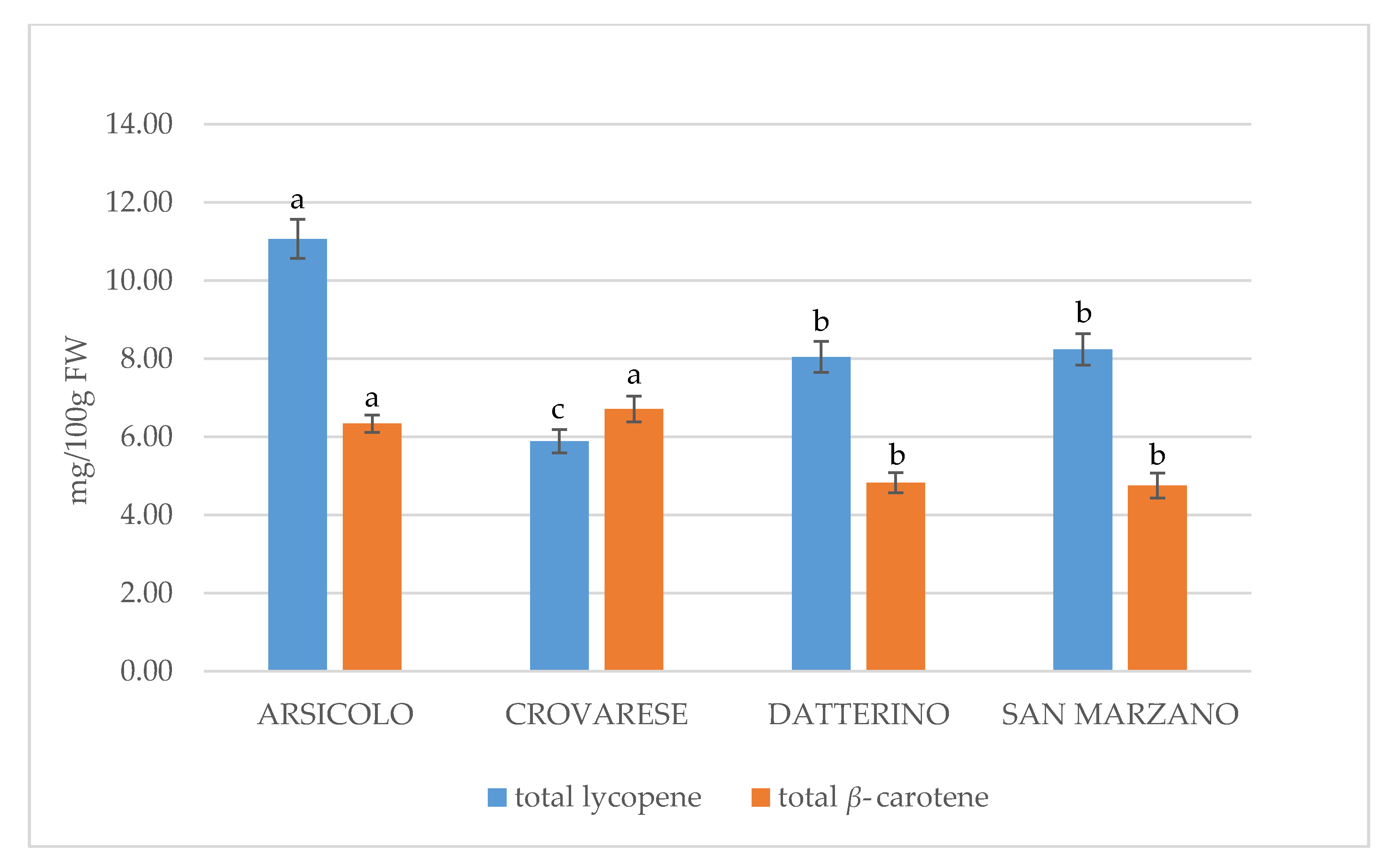
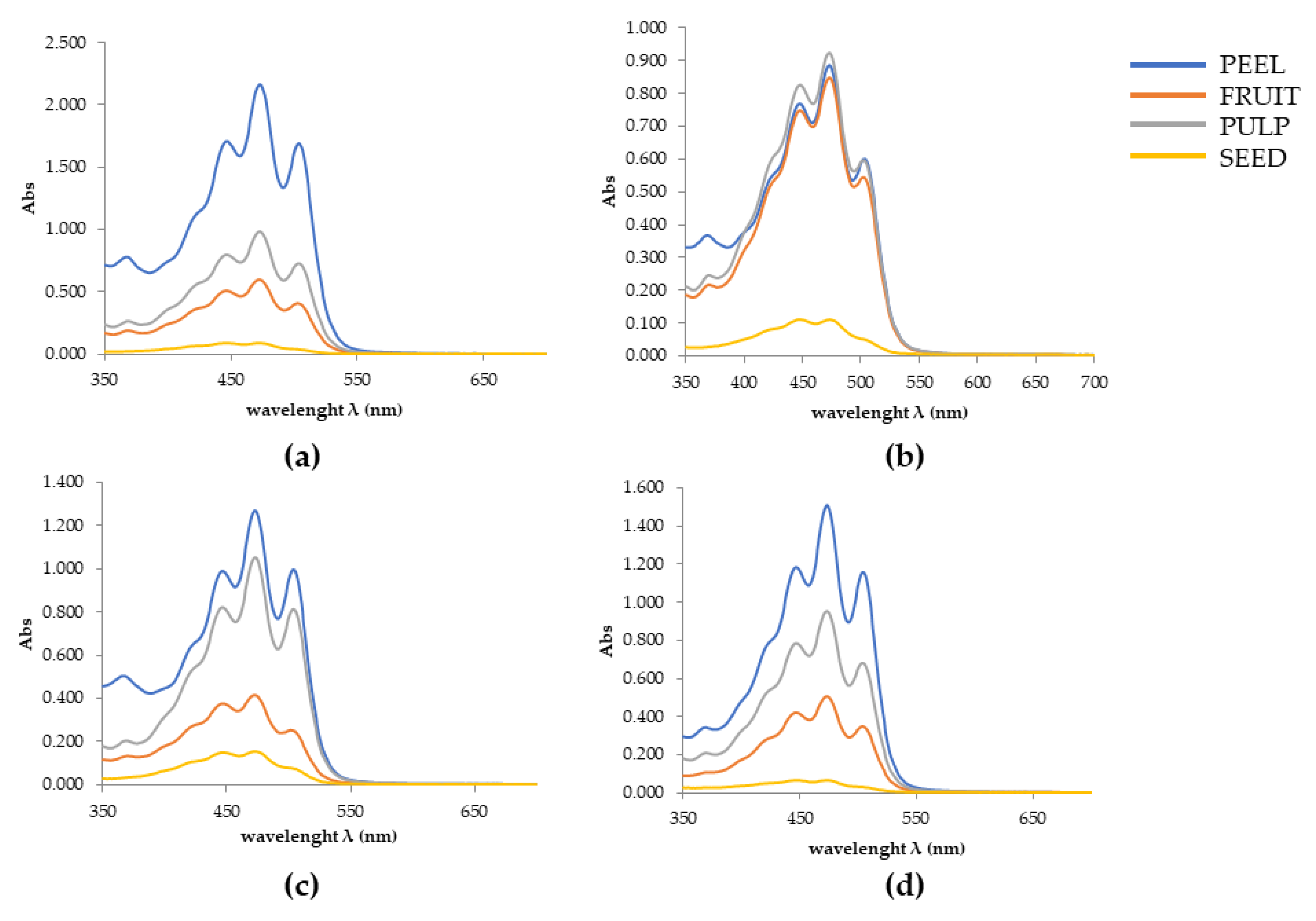
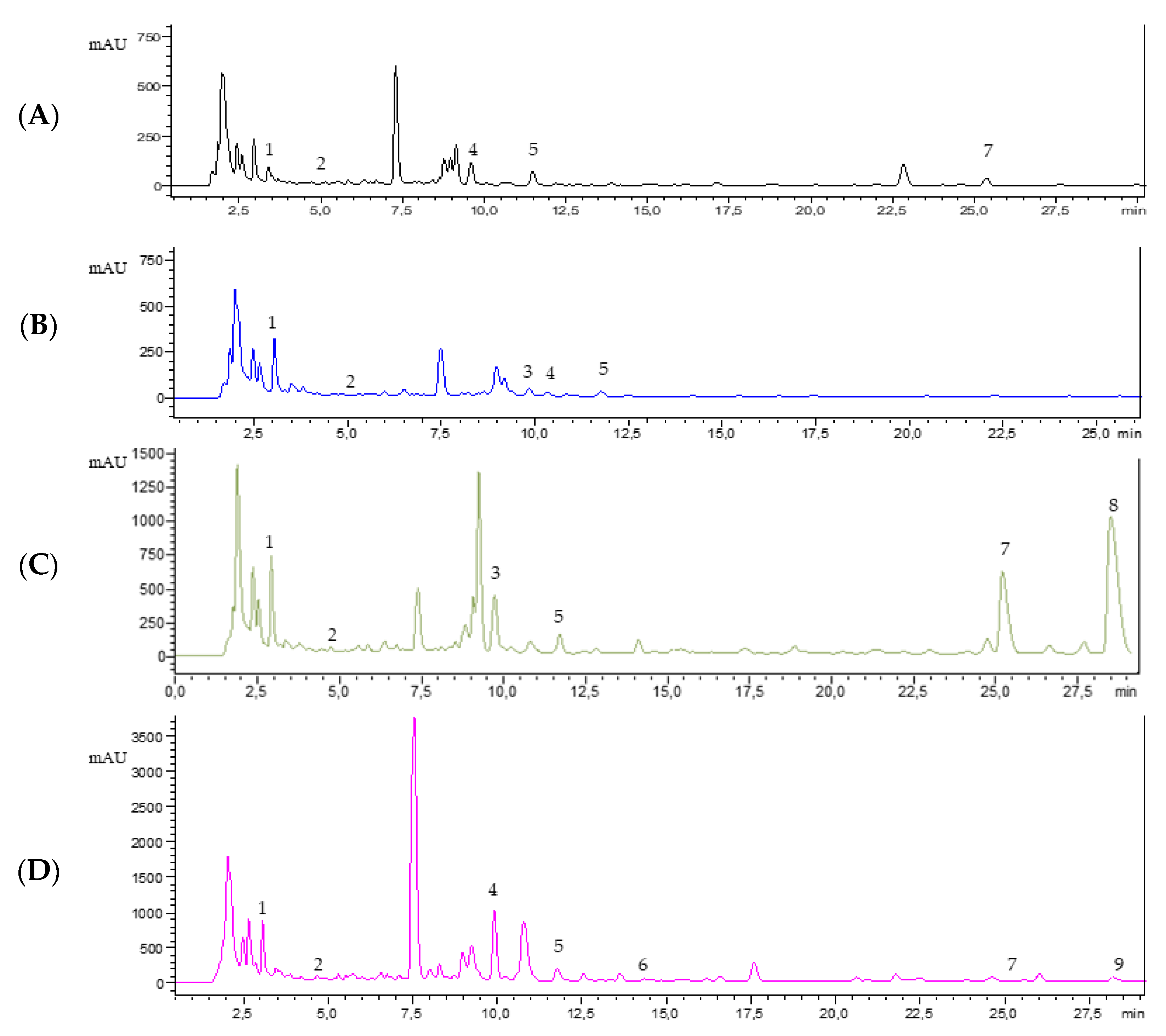
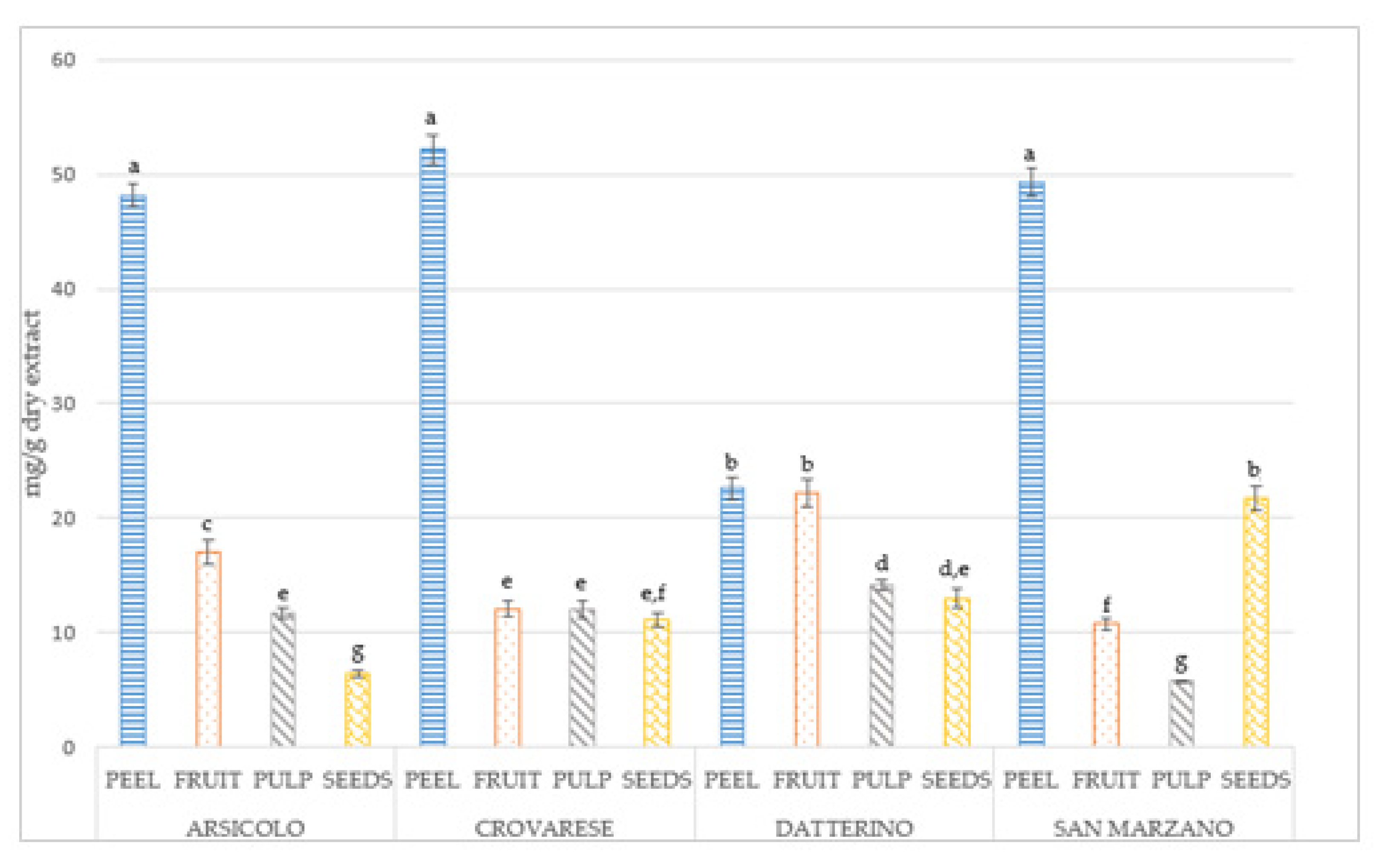
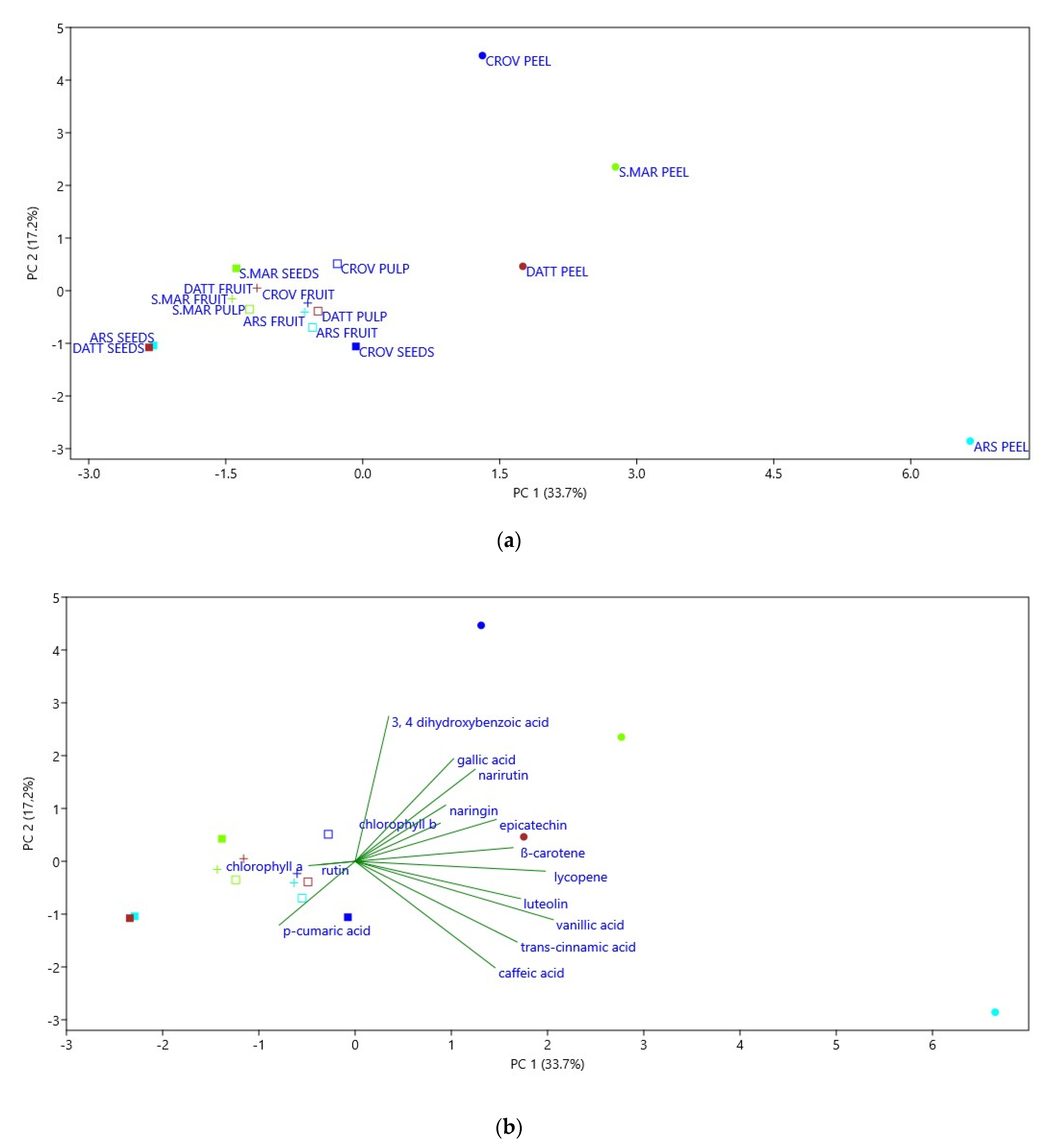
| Samples | DPPH (mg TE/100 g FW) |
|---|---|
| ARSICOLO PEEL | 70.34 ± 7.97 c |
| ARSICOLO FRUIT | 30.44 ± 3.18 f |
| ARSICOLO PULP | 11.14 ± 1.25 i |
| ARSICOLO SEEDS | 18.33 ± 1.7 h |
| CROVARESE PEEL | 111.32 ± 11.81 a |
| CROVARESE FRUIT | 40.38 ± 4.66 e |
| CROVARESE PULP | 25.98 ± 3.44 g |
| CROVARESE SEEDS | 38.32 ± 2.18 e |
| DATTERINO PEEL | 60.13 ± 3.88 c |
| DATTERINO FRUIT | 86.79 ± 6.17 b |
| DATTERINO PULP | 41.7 ± 4.27 e |
| DATTERINO SEEDS | 50.4 ± 5.93 d |
| SAN MARZANO PEEL | 67.81 ± 5.94 c |
| SAN MARZANO FRUIT | 54.88 ± 3.08 d |
| SAN MARZANO PULP | 39.03 ± 1.73 e |
| SAN MARZANO SEEDS | 42.03 ± 3.28 e |
| Samples | mg β-Carotene/100 g FW | mg Lycopene/100 g FW | mg Chlorophyll a/100 g FW | mg Chlorophyll b/100 g FW |
|---|---|---|---|---|
| ARSICOLO PEEL | 2.98 ± 0.15 a | 6.48 ± 0.52 a | 0.04 ± 0.00 c | 0.06 ± 0.008 d,e |
| ARSICOLO FRUIT | 1.18 ± 0.09 e,f | 1.39 ± 0.10 f | 0.01 ± 0.00 f | 0.04 ± 0.005 f,g |
| ARSICOLO PULP | 1.83 ± 0.13 b–d | 3.10 ± 0.26 c | 0.03 ± 0.00 d | 0.04 ± 0.005 f,g |
| ARSICOLO SEEDS | 0.35 ± 0.05 h | 0.10 ± 0.01 h | 0.04 ± 0.01 c | 0.06 ± 0.007 d,e |
| CROVARESE PEEL | 1.89 ± 0.18 b,c | 2.01 ± 0.20 d,e | 0.03 ± 0.01 d | 0.05 ± 0.01 e,f |
| CROVARESE FRUIT | 2.06 ± 0.22 b,c | 1.75 ± 0.15 e,f | 0.04 ± 0.00 c | 0.03 ± 0.00 g,h |
| CROVARESE PULP | 2.34 ± 0.20 b | 1.99 ± 0.26 d,e | 0.06 ± 0.01 a | 0.09 ± 0.01 b,c |
| CROVARESE SEEDS | 0.43 ± 0.05 h | 0.14 ± 0.02 h | 0.05 ± 0.01 b | 0.06 ± 0.01 d,e |
| DATTERINO PEEL | 1.56 ± 0.13 c–e | 3.76 ± 0.45 b | 0.03 ± 0.01 d | 0.06 ± 0.01 d,e |
| DATTERINO FRUIT | 1.29 ± 0.10 d–f | 0.92 ± 0.10 g | 0.01 ± 0.00 f | 0.01 ± 0.01 i |
| DATTERINO PULP | 1.35 ± 0.10 d–f | 3.13 ± 0.29 c | 0.02 ± 0.00 e | 0.06 ± 0.01 d,e |
| DATTERINO SEEDS | 0.63 ± 0.05 g,h | 0.24 ± 0.03 h | 0.01 ± 0.00 f | 0.02 ± 0.00 h |
| SAN MARZANO PEEL | 1.91 ± 0.20 b,c | 4.28 ± 0.50 b | 0.05 ± 0.00 b | 0.07 ± 0.01 c,d |
| SAN MARZANO FRUIT | 1.01 ± 0.12 f,g | 1.43 ± 0.14 f | 0.06 ± 0.01 a | 0.13 ± 0.02 a |
| SAN MARZANO PULP | 1.64 ± 0.17 c–e | 2.42 ± 0.38 d | 0.01 ± 0.00 f | 0.02 ± 0.00 h |
| SAN MARZANO SEEDS | 0.2 ± 0.02 h | 0.11 ± 0.01 h | 0.06 ± 0.01 a | 0.10 ± 0.02 b |
| SAMPLES | ||||||||||||||||
|---|---|---|---|---|---|---|---|---|---|---|---|---|---|---|---|---|
| AS | AF | AP | ASD | CS | CF | CP | CSD | DS | DF | DP | DSD | SMS | SMF | SMP | SMSD | |
| 1 | 8.57 ± 0.69 c,d | 7.89 ± 0.45 c,d | 9.65 ± 0.70 b,c | 3.34 ± 0.23 g,h | 18.32 ± 1.48 a | 8.25 ± 0.52 c,d | 7.48 ± 0.33 d,e | 3.14 ± 0.12 h | 11.93 ± 0.94 b | 4.67 ± 0.24 f | 4.48 ± 0.25 f | 4.55 ± 0.38 f | 7.2 ± 0.55 d,e | 6.3 ± 0.43 e | 3.94 ± 0.25 f,g | 3.74 ± 0.45 g,h |
| 2 | 13.33 ± 0.80 a | 0.89 ± 0.05 h | nd | 0.64 ± 0.03 i | 1.02 ± 0.1 g,h | 1.06 ± 0.09 f,g | 1.42 ± 0.08 e | 2.54 ± 0.09 c | 1.91 ± 0.08 d | 1.28 ± 0.05 e | 1.24 ± 0.05 e,f | 0.261 ± 0.01 j | 4.23 ± 0.20 b | nd | 0.56 ± 0.03 i | nd |
| 3 | nd | nd | nd | nd | 2.38 ± 0.14 a | 0.04 ± 0.00 f | 0.71 ± 0.03 b,c | 0.41 ± 0.02 c,d | 0.93 ± 0.08 b | 0.39 ± 0.02 c,d | 0.39 ± 0.02 c,d | 0.28 ± 0.00 d | 0.77 ± 0.06 b | 0.13 ± 0.00 e | 0.42 ± 0.03 c,d | 1.08 ± 0.87 b |
| 4 | 1.08 ± 0.09 a | 0.07 ± 0.01 f | 0.31 ± 0.00 b | nd | nd | 0.05 ± 0.00 g | 0.14 ± 0.02 d | 0.28 ± 0.01 b | nd | 0.07 ± 0.01 f | 0.30 ± 0.02 b | 0.15 ± 0.03 d | nd | 0.20 ± 0.01 c | 0.12 ± 0.04 d | 0.1 ± 0.00 e |
| 5 | 3.39 ± 0.24 c | 2.32 ± 0.01 e,f | 1.35 ± 0.09 g | 1.05 ± 0.08 h | 2.65 ± 0.42 d,e | 2.06 ± 0.35 f | 2.08 ± 0.13 f | 3.59 ± 0.02 c | 4.37 ± 0.25 b | 3.5 ± 0.09 c | 2.82 ± 0.04 d | 1.05 ± 0.1 h | 5.59 ± 0.35 a | 0.20 ± 0.04 k | 0.74 ± 0.1 i | 0.44 ± 0.03 j |
| 6 | 17.97 ± 1.24 a,b | 3.99 ± 2.44 c,d | nd | 0.48 ± 0.17 e | 27.65 ± 5.77 a | 0.45 ± 0.15 e | nd | nd | 1.52 ± 1.14 d | 7.43 ± 3.55 c | nd | 5.74 ± 1.44 c | 17.64 ± 1.65 a,b | 3.9 ± 0.64 c,d | nd | 14 ± 1.54 b |
| 7 | 1.4 ± 0.67 b | 1.2 ± 0.36 b | nd | nd | nd | nd | nd | nd | nd | nd | nd | nd | 13.42 ± 5.44 a | nd | nd | nd |
| 8 | nd | nd | nd | nd | nd | nd | nd | nd | 0.45 ± 0.03 c | 4.69 ± 0.05 a | 4.73 ± 0.03 a | nd | nd | nd | nd | 1.39 ± 0.1 b |
| 9 | 1.1 ± 0.10 a | 0.20 ± 0.02 f | nd | nd | 0.13 ± 0.08 f | 0.12 ± 0.01 f | 0.10 ± 0.00 f | 0.54 ± 0.03 c,d | 0.63 ± 0.05 b,c | nd | nd | 0.02 ± 0.00 f | 0.43 ± 0.03 d | nd | nd | 0.74 ± 0.07 b |
| 10 | 0.24 ± 0.01 b,c | 0.25 ± 0.01 b | 0.25 ± 0.01 b | 0.69 ± 0.44 a | nd | 0.05 ± 0.00 d | 0.07 ± 0.00 d | nd | 0.25 ± 0.01 b | 0.17 ± 0.01 b,c | 0.16 ± 0.00 c | 0.89 ± 0.07 a | nd | nd | nd | 0.26 ± 0.01 b |
| 11 | 1.03 ± 0.05 a | 0.20 ± 0.01 c | 0.14 ± 0.00 d | 0.14 ± 0.01 d | nd | nd | nd | 0.55 ± 0.02 b | 0.61 ± 0.05 b | nd | nd | nd | nd | nd | nd | nd |
| TOT | 48.17 ± 3.89 a | 17.02 ± 3.36 c,d | 11.71 ± 0.80 e,f | 6.33 ± 0.96 g | 52.15 ± 7.99 a | 12.08 ± 1.12 e,f | 12.01 ± 0.59 e,f | 11.05 ± 0.31 f | 22.59 ± 2.63 b | 22.20 ± 4.02 b,c | 14.12 ± 0.41 d,e | 12.95 ± 1.94 d–f | 49.28 ± 8.28 a | 10.73 ± 1.12 f | 5.78 ± 0.45 g | 21.71 ± 3.07 b,c |
Publisher’s Note: MDPI stays neutral with regard to jurisdictional claims in published maps and institutional affiliations. |
© 2021 by the authors. Licensee MDPI, Basel, Switzerland. This article is an open access article distributed under the terms and conditions of the Creative Commons Attribution (CC BY) license (http://creativecommons.org/licenses/by/4.0/).
Share and Cite
Faraone, I.; Russo, D.; Ponticelli, M.; Candido, V.; Castronuovo, D.; Cardone, L.; Sinisgalli, C.; Labanca, F.; Milella, L. Preserving Biodiversity as Source of Health Promoting Compounds: Phenolic Profile and Biological Activity of Four Varieties of Solanum lycopersicum L. Plants 2021, 10, 447. https://doi.org/10.3390/plants10030447
Faraone I, Russo D, Ponticelli M, Candido V, Castronuovo D, Cardone L, Sinisgalli C, Labanca F, Milella L. Preserving Biodiversity as Source of Health Promoting Compounds: Phenolic Profile and Biological Activity of Four Varieties of Solanum lycopersicum L. Plants. 2021; 10(3):447. https://doi.org/10.3390/plants10030447
Chicago/Turabian StyleFaraone, Immacolata, Daniela Russo, Maria Ponticelli, Vincenzo Candido, Donato Castronuovo, Loriana Cardone, Chiara Sinisgalli, Fabiana Labanca, and Luigi Milella. 2021. "Preserving Biodiversity as Source of Health Promoting Compounds: Phenolic Profile and Biological Activity of Four Varieties of Solanum lycopersicum L." Plants 10, no. 3: 447. https://doi.org/10.3390/plants10030447
APA StyleFaraone, I., Russo, D., Ponticelli, M., Candido, V., Castronuovo, D., Cardone, L., Sinisgalli, C., Labanca, F., & Milella, L. (2021). Preserving Biodiversity as Source of Health Promoting Compounds: Phenolic Profile and Biological Activity of Four Varieties of Solanum lycopersicum L. Plants, 10(3), 447. https://doi.org/10.3390/plants10030447









